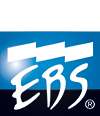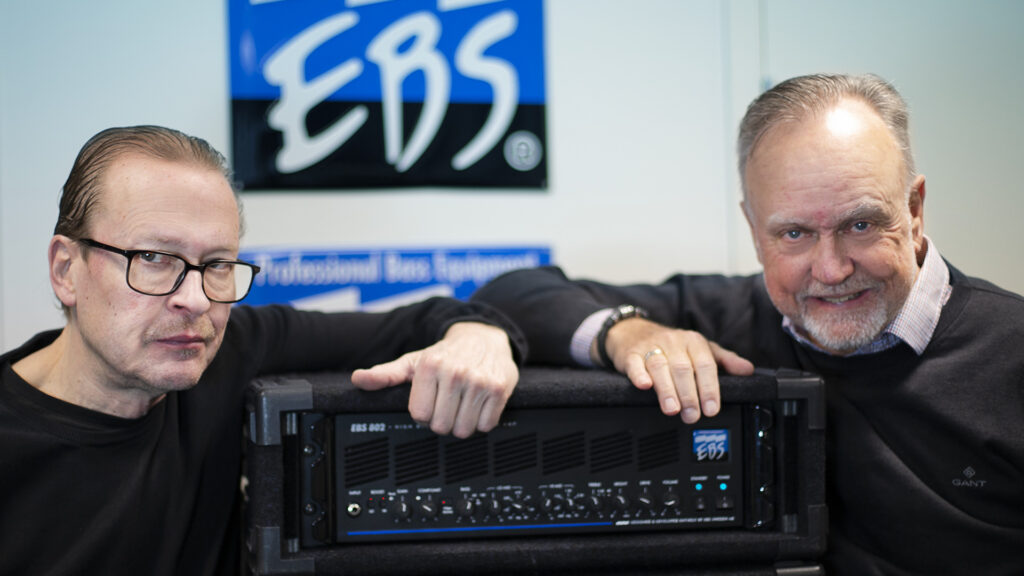
Interviewed by independent journalist Joel McIver in January 2023.
Thirty-five years is a long time to be in business. The Beatles only managed eight years. ABBA just about made it to ten. Even Led Zeppelin split after only twelve—and yet the unique creative partnership of Bo L. Engberg and Mats Kristoffersson, the CEO and Technical Director respectively of the pioneering amp and effects company EBS, is as strong as ever after a third of a century and counting.
“Thirty-five years?” I can hardly believe it!, chuckles Bo when we ask him how he and Mats have managed to stay the course for so long. “You know, I’ve always had a voice in my head that said ‘Never give up—keep going!’”
Sound business sense and determination aren’t the only factors behind the company’s success, though. The fact that Bo and Mats complement each other so well, not just in business and product design but also in personality, has played a huge part.
«You know, I’ve always had a voice in my head that said ‘Never give up—keep going!’»
Bo L. Engberg, CEO of EBS Professional Bass Equipment
“He and I are very different in every way,” chuckles Bo, “but we’re a very good team. I’m an extrovert, so I have no problem with meeting people, anywhere and everywhere. My other strength is that I can run the business efficiently. Mats is an incredible designer and builder. I’ve never seen anyone else like him. He can handle tubes, transistors, and digital technology—he has no limits.”
From this description by his effervescent business partner, you’d expect Mats to be a quiet fellow who keeps his own counsel, and indeed EBS’s design supremo is more reflective than outspoken. Dig deeper, though, and he admits that as a teenage electronics whiz, he once boasted: “I’m going to build the best bass amp in the world one day!”
Asked if he’s achieved this goal yet, Mats laughs and says: “I know we’ve made some incredible amps here because some of the world’s greatest bassists tell us that themselves. Are they the best in the world? I’ll let those players decide—and you know what? There are still bass amps to come.”
The Early Days
When I was a small boy, even before I started school, begins Bo, “I had three big interests—music, electronics, and business. I had no problem with the first one, but I knew nothing about the other two: I just knew I liked them. When I was a kid, music was the most important of the three. One of my friends at school made a bass guitar—a very bad one!—but I played it and I loved it.”
Like Bo, Mats was an early starter when it came to playing music. “I started playing drums when I was nine and moved to bass a year later,” he remembers. “I went to a very good music school, and I moved pretty fast: I was playing jazz-rock and Santana covers by the late Seventies. I was pretty dedicated—sometimes I’d rehearse or play shows six days a week. It was tough, with 15 guys on stage and not much money between us all, but we had a great time.”

Rocking out was fun for Bo too, but he already knew he wanted to go into a music-related business rather than pay his bills as a musician. “I played in a weekend band, but it was just a hobby,” he says. “My first amp was a 30-watt Hagstrom with two 15-inch speakers. It wasn’t very loud, but it was fun. My bass was an Epiphone. I didn’t have any money, so that was all I could afford.”
And the name of his band? “We called ourselves Järngänget, which means Iron Gang, ha ha! Later I joined Stämmbandet, playing Chicago covers, and finally, I ended up in a band called Moby Dick. After that I worked as a studio and production technician for a long time, around 15 years, but I was always planning to set up an electronics and audio company. One of my early ventures into gear design had already taken place in 1979, when I started my first company and developed a guitar amp for a Swedish guitar dealer, Jan Hallquisth. Jan’s nickname was ‘Halkan’, so that’s what I called his amp.”
The decision to enter electronics was equally easy for Mats, who remembers: “The moment came when I had to choose whether to enter a technical career or become a professional musician, but I always knew which way to go.”
Taking Effect
By 1985 Bo had plunged his savings into his company, Efekt Elektronik—misspelled with a single F because another company existed called Effekt Elektronik when he tried to register the name. He didn’t bother seeking out venture capital or private equity, preferring to finance everything himself and maintain complete control.
Meanwhile, Mats was hard at work studying electronics, and this was where the two men first crossed paths. “I had a dream in 1985,” explains Bo. “I wanted to create a kind of Kalman filter that reduces feedback from acoustic instruments and automatically tunes them by reducing their resonant frequencies. I asked two guys who knew electronics to come in and try to solve this problem, but it was too advanced for them.”
Fortunately for Bo and the future of the bass gear industry, the young electronics enthusiasts knew where to go for help. “They said to me, ‘We have a guy in our class called Mats Kristoffersson who helps companies out with this kind of thing’,” adds Bo. “They talked to him and he came by. I
presented my idea to Mats, and he solved the problem—and then he said, ‘Okay, what’s our next project?’ That’s how we started working together.”
The turning-point came in 1988 when Bo told Mats about a concept he had for a bass guitar preamplifier. The idea behind the unit was to make a simple but incredible-sounding preamp based on the highest-quality components available.

The initials of the new Efekt Bass System were soon adopted by users as the name of the company that made it, and so EBS was born, with the EBS-1 preamp as its launch product. “After that, we changed our focus, because we now knew what we wanted to do,” nods Mats, pointing to a whole list of new innovations that followed shortly afterward. “We were the first company to put a treble horn in a 4×10” cab, and among the first to put a compressor in an amplifier,” he explains, noting in passing that these features are now commonplace worldwide.
Milestones
By 1992 EBS had developed and launched several new power amps, including the EPS-600, EP-200, and EB-800, as well as several cabinet models and the 240-watt Taurus combo. The last of these was a dream come true for bassists looking for the perfect balance of portability and tone modulation.
“It was our first combo,” says Bo, “so we wanted to do something very special with it. We came up with the idea of filling it with effects—a compressor, octaver, and chorus. This was really new for bass players: they hadn’t seen this before.”
«I know we’ve made some incredible amps here, because some of the world’s greatest bassists tell us that themselves.»
Mats Kristoffersson, Tech Director of EBS Professional Bass Equipment
The Taurus effects were so popular that a whole new product line was born for EBS when Bo and Mats split the effects away from the amp and sold them as individual pedals. “People loved the effects that were in the amps,” explains Bo, “so I told Mats, ‘Why don’t we take them out and make separate pedals instead of having them built into the amplifier?’”
In 1995, the Fafner hybrid bass amp—a preamp and power amp occupying the same unit—was launched. Named after a fearsome dragon from Norse mythology, the Fafner quickly stamped the EBS name across this market sector, and returned in 2011 as the Fafner II Extreme Edition. A dual-channel beast, the Fafner II became widely used by bands across the genre spectrum: at one point, three out of the five nominees in the American Grammy Awards’ Metal Album Of The Year category were recorded with an EBS Fafner II, including the winning album—even though none of the bassists concerned were official EBS endorsers.

By the late Nineties, EBS equipment had spread across the globe and was available in Japan, the USA and most of Europe. When the company’s tenth anniversary came around, its catalogue included the Fafner amp, combos, cabinets and pedals—including the famous UniChorus, MultiComp and OctaBass—as well as all manner of accessories. An Anniversary edition of the EBS-1 appeared in 1998, the Classic-1, reminding us which preamp started it all.
In more recent years, EBS has developed the two popular HD360 and TD660 solid-state amplifiers. The HD has become a favourite with artists such as Tal Wilkenfeld, while the TD is often seen among backline rentals as well as on tour.
As the years have passed, EBS has continued to respond to the changing demands of the marketplace. The NeoLine cab series found a ready home among metal bands from Sweden and abroad thanks to their punchy response, while the EBS Classic line of cabinets and amps was immediately embraced by a new wave of classic rock bands who needed warmth, power and reliability from their bass gear.
Take note, too, of the remarkable technology behind the lightweight Class-D Reidmar range of amps, launched in 2011. In ancient Norse literature, Reidmar was the dwarf who slew Fafner, although in EBS’s case the two products coexist peacefully. Mats’s Soft Clip solution ensures that sound quality is maintained even when the automatic limiter that controls clipping is pushed to its limits, a formerly insoluble issue for Class-D amps.
These days, you’ll find dozens of EBS products ready for the world’s bassists. There’s no stopping EBS now.

The People—And The Future
EBS has an enviable range of high-profile bass players on its roster. Back in the early days, renowned bassists such as Stefan Brolund and the late Kofi-Bentsi Enchill were invaluable partners for EBS, for their feedback during the product development process as well as their roadshow appearances.
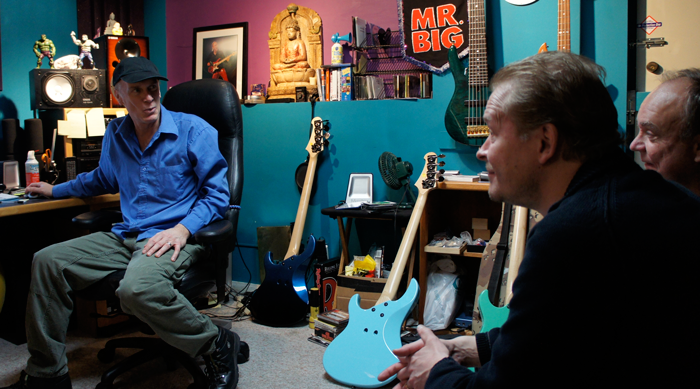
Two world-renowned bass players that you’ll see proudly using EBS pedals are Billy Sheehan and Stanley Clarke. Billy’s acclaimed Drive pedal is the result of painstaking research, with the great bassist and the company designers working together to build the ultimate overdrive. The original version of the Drive was introduced at Winter NAMM 2013, while the later Deluxe model added even more essential functionality.
As for the Stanley Clarke Signature Wah-Wah/Tone Filter pedal, which offers the player wah and tone filter options as well as the ability to approach the Clarke active tone with a passive bass, it’s the perfect synthesis of bass innovation and manufacturing know-how. EBS also released Stanley’s signature Acoustic Preamp in 2021, an essential unit for any upright bass player.
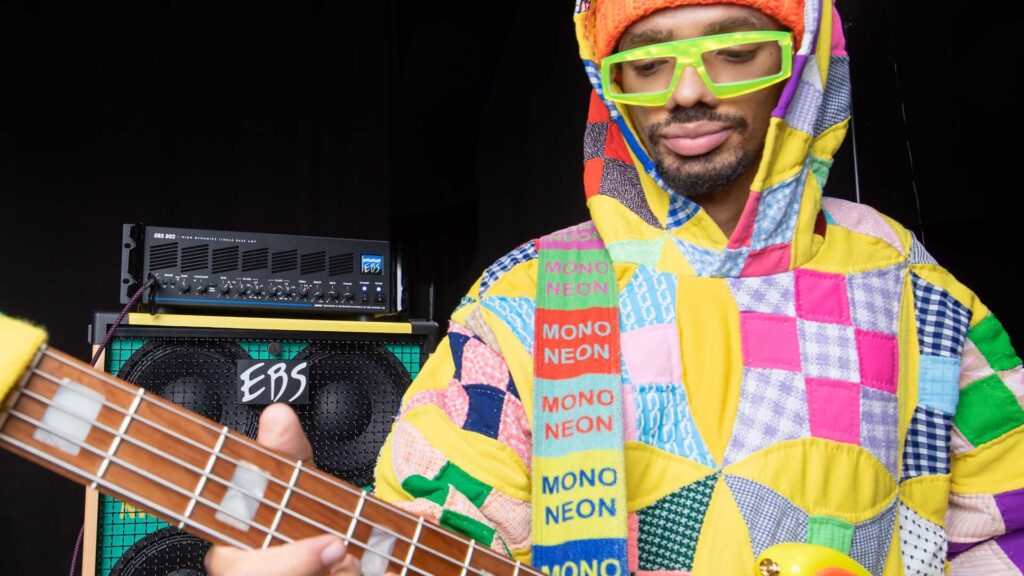
Other artists whose collaborations with EBS have been long and productive include the session great Tal Wilkenfeld; Henrik Linder of the unique Dirty Loops; and Prince’s former bassist Dywane Thomas Jr., better known as MonoNeon. The music of the pop star Harry Styles, who won a Grammy for Album of the Year in early 2023, also rests on EBS thanks to Elin Sandberg, a Swede who the company has supported since she was 17, just before she moved to the USA to study at Berklee.
If you’re an American football fan, you may have heard the EBS bass tone underpinning recent half-time shows led by musical director and bassist Adam Blackstone. Meanwhile, another high-profile EBS user is Alex Al, the bass player on the Arsenio Hall and George Lopez shows, who has played with a list of world-class artists such as Michael Jackson, Stevie Wonder, George Benson, Herbie Hancock, and Lionel Richie.

Sweden is known internationally for its heavy metal bands, and many heavyweight bassists from that movement, particularly its Gothenburg branch, trust EBS to deliver the low end. These include the former In Flames, now The Halo Effect bass player Peter Iwers and At The Gates founder Jonas Björler. American metal titans Steve Di Giorgio of Testament and John Campbell of Lamb Of God also place their faith in EBS: it’s little surprise that the company is the main bass backline provider at the annual Sweden Rock Festival, the country’s biggest event for lovers of loud music.
Ask Bo to name a memorable EBS moment from the last 35 years and he’ll tell you about the night that the old millennium became the new one. “I’ll always remember December 31, 1999!” he tells us. “We were watching the Swedish rock group Europe, who were playing their huge hit ‘The Final Countdown’ on a boat in the middle of Stockholm. It was minus 15 degrees—really, really cold—and they were using the biggest amp rig that EBS has ever built. The sound was incredible, and it was a total validation for us of all the hard work we’d done to get to that point.”
It’s 24 years since that memorable night, but the mission to serve bassists’ needs continues as strongly as ever with the launch of the new EBS Magni 502 combo, an amp for which your lower back will thank you forever. “The Magni is very loud, and very light,” confirms Mats. “It’s actually the lightest bass combo we’ve ever made, at around 15 kilos, or 33 pounds, and it has a double porting system so the sound will go everywhere. The drummer sitting next to you will say, ‘Hey, you sound great!’
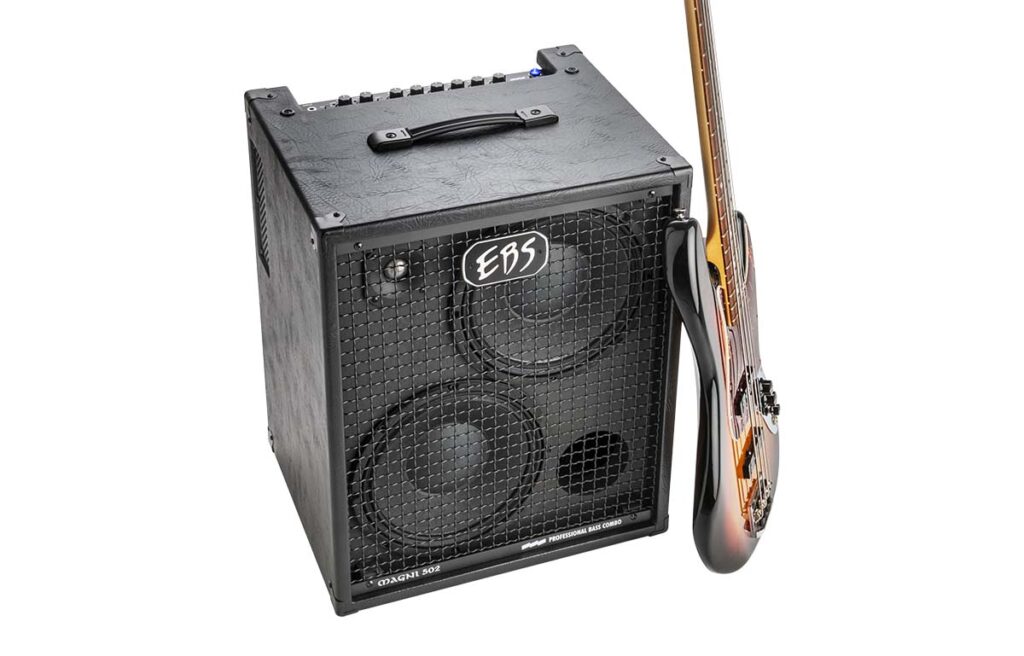
Ultimately, EBS is able to meet the needs of a huge international community of bass players because Bo and Mats are the same people at heart that they used to be all those years ago—bassists who love music in all its forms.
“It’s simple,” says Bo. “EBS is staffed by dedicated musicians whose interest and focus is bass. Our company represents every imaginable style of music—rock, pop, blues, jazz, funk, Latin, traditional folk music and so on. For us, there are no boundaries. Music touches me, regardless of style, musician or lyrical message—everything from classical music to metal.”
Thirty-five years since Bo and Mats put their heads together and the EBS-1 was born, their mission is the same as it ever was. “As a bass player, you have a dream tone in mind,” says Bo. “That tone is what we’ll deliver to you. Just as we were in 1988, we’re at your service!”
Want to celebrate the 35th Anniversary in style?
Get the Limited Edition t-shirts available at our webshop.
